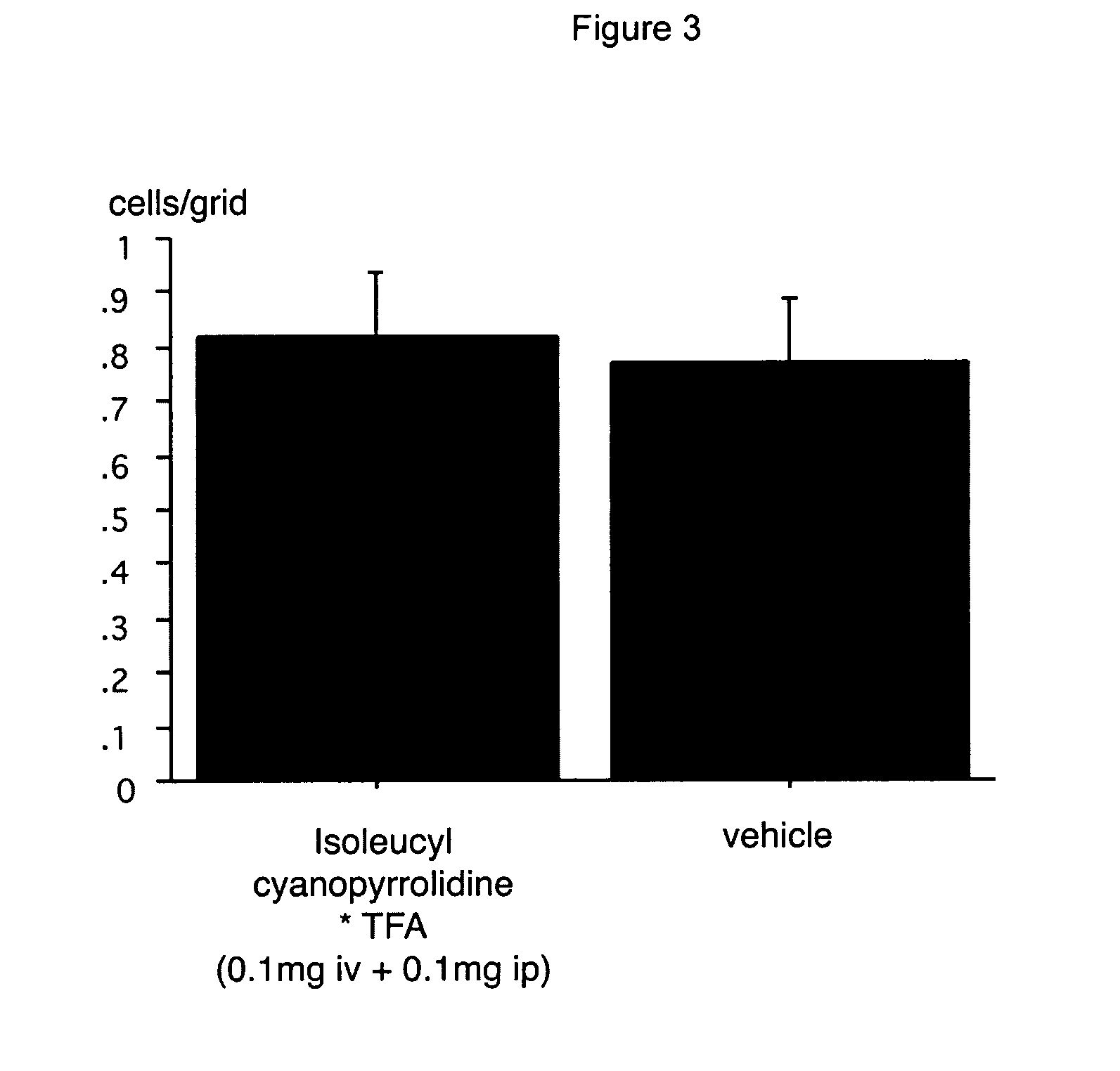Dipeptidyl peptidase IV inhibitors and their uses as anti-cancer agents
a technology of dipeptidase and inhibitor, which is applied in the direction of peptide/protein ingredients, peptide sources, applications, etc., can solve the problems of abnormal cells that invade nearby tissue, cancerous masses called tumors, and abnormal cells that can become abnormal, so as to reduce the expression of ectopeptidase dpiv, reduce lung metastasis, and reduce the adhesion of cancer cells
- Summary
- Abstract
- Description
- Claims
- Application Information
AI Technical Summary
Benefits of technology
Problems solved by technology
Method used
Image
Examples
example 1
Synthesis of Dipeptide Compounds
1.1 General Synthesis of Isoleucyl Thiazolidine Salt
[0198]The Boc-protected amino acid BOC-Ile-OH is placed in ethyl acetate and the batch is cooled to about −5° C. N-Methylmorpholine is added dropwise, pivalic acid chloride (on a laboratory scale) or neohexanoyl chloride (on a pilot-plant scale) is added dropwise at constant temperature. The reaction is stirred for a few minutes for activation. N-Methylmorpholine (laboratory scale) and thiazolidine hydrochloride (laboratory scale) are added dropwise in succession, thiazolidine (pilot-plant scale) is added. Working-up in the laboratory is effected in conventional manner using salt solutions, on a pilot-plant scale the batch is purified with NaOH and CH3COOH solutions.
[0199]The removal of the BOC protecting group is carried out using HCl / dioxane (laboratory scale) or H2SO4 (pilot-plant scale). In the laboratory the hydrochloride is crystallised from EtOH / ether.
[0200]On a pilot-plant scale the free amin...
example 2
Chemical Characterization of Selected Dipeptide Compounds
2.1 Melting Point Determination
[0216]Melting points were determined on a Kofler heating platform microscope from Leica Aktiengesellschaft, the values are not corrected, or on a DSC apparatus (Heumann-Pharma).
2.2 Optical Rotation
[0217]The rotation values were recorded at different wavelengths on a “Polarimeter 341” or higher, from the Perkin-Elmer company.
2.3 Measurement Conditions for the Mass Spectroscopy
[0218]The mass spectra were recorded by means of electrospray ionisation (ESI) on an “API 165” or “API 365” from the PE Sciex company. The operation is carried out using an approximate concentration of c=10 μg / ml, the substance is taken up in MeOH / H2O 50:50, 0.1% HCO2H, the infusion is effected using a spray pump (20 μl / min). The measurement were made in positive mode [M+H]+, the ESI voltage is U=5600V.
2.4. Results
2.4.1 Tests on Isoleucyl Thiazolidine Fumarate (Isomer)
[0219]
SubstanceMp (° C.)CE (min)MS[α]H2OL-threo-IT*F150DSC...
example 3
Synthesis of Xaa-Pro-Yaa Tripeptides
[0222]All syntheses were carried out on a peptide synthesizer SP 650 (Labortec AG) applying Fmoc / tBu-strategy. Protected amino acids were purchased from Novabiochem or Bachem. trifluoro acetic acid (TFA) was purchased from Merck, triisopropyl silane (TIS) was purchased from Fluka.
[0223]Pre-loaded Fmoc-Yaa-Wang resin (2.8 g / substitution level 0.57 mmol / g) was deprotected using 20% piperidine / N,N-dimethylformamide (DMF). After washing with DMF a solution of 2 eq (1.1 g) of Fmoc-Pro-OH were solved in DMF (12 ml solvent per gram resin). 2 eq (1.04 g) of 2-(1H-Benzotriazole 1-yl)-1,1,3,3-tetramethyluronium tetrafluoroborate (TBTU) and 4 eq (1.11 ml) of N,N-diisopropylethylamine (DIEA) were added and placed in the reaction vessel. The mixture was shaken at room temperature for 20 minutes. Then the coupling cycle was repeated. After subsequent washing with DMF, dichlormethane, isopropanol and diethyl ether the resulting Fmoc-Pro-IIe-Wang resin was dried ...
PUM
 Login to View More
Login to View More Abstract
Description
Claims
Application Information
 Login to View More
Login to View More - R&D
- Intellectual Property
- Life Sciences
- Materials
- Tech Scout
- Unparalleled Data Quality
- Higher Quality Content
- 60% Fewer Hallucinations
Browse by: Latest US Patents, China's latest patents, Technical Efficacy Thesaurus, Application Domain, Technology Topic, Popular Technical Reports.
© 2025 PatSnap. All rights reserved.Legal|Privacy policy|Modern Slavery Act Transparency Statement|Sitemap|About US| Contact US: help@patsnap.com



